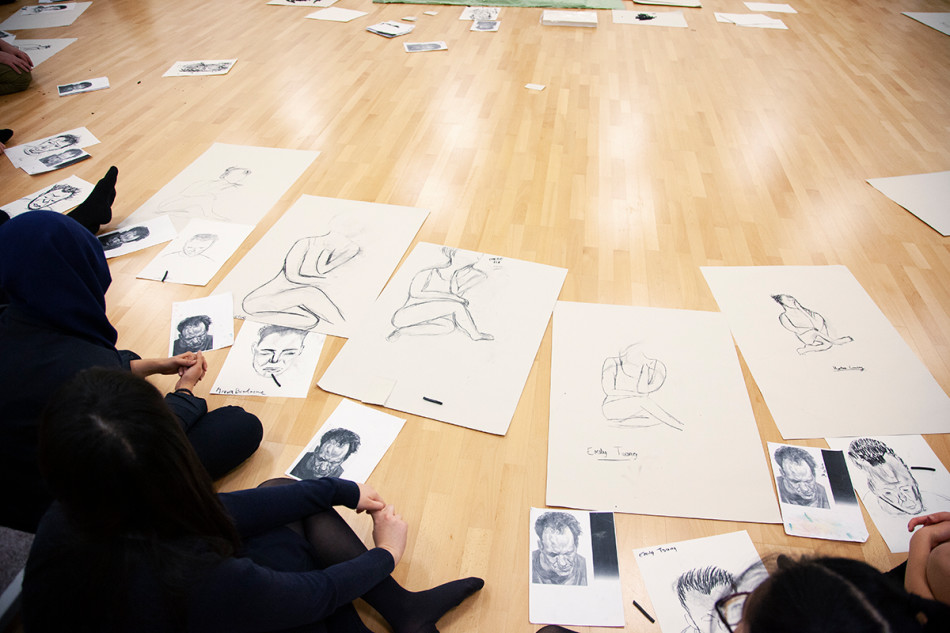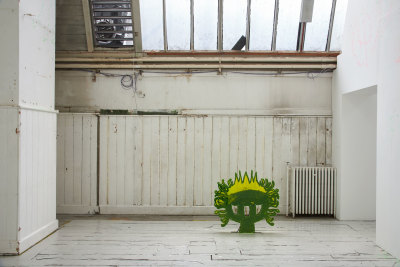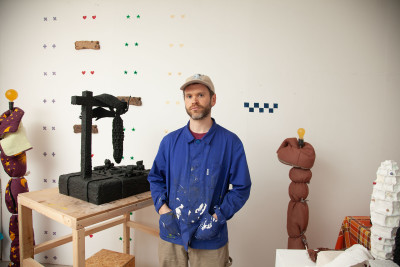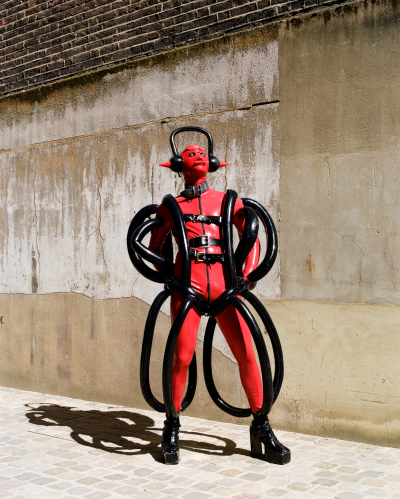Art under threat: why teaching’s in decline in our schools
Art under threat: why teaching’s in decline in our schools
By Amy Sherlock
Published 20 March 2019
Amy Sherlock addresses the slump in art teaching in Britain’s schools, and the effect this has on the art education ecosystem.
-
From the Spring 2019 issue of RA Magazine, issued quarterly to Friends of the RA. This issue is an arts education special, to mark the 250th anniversary of the RA Schools.
-
It is a miserable morning. The windows fog with condensation as the packed bus crawls through rush-hour traffic. Not for the first time in my life, I am running late for school.I’m on my way to Eltham Hill School, in Greenwich, south London, to sit in on a life-drawing workshop run by the Royal Academy for a group of GSCE and A-level art and design students. Today’s session will be directed by the artist Paul Brandford, an RA Schools alumnus of the 1980s, who has been leading workshops since the RA’s outreach programme was in its infancy (its school workshops began in 1989.) Joining Brandford is his regular co-conspirator, Anna Bird, who is modelling. She enters the school’s dance room, where the workshop is taking place, wrapped in a bathrobe. As there will be students under the age of 16 in the session, Bird wears a thin leotard rather than posing naked. Technicians unroll mats in the centre of the room and bring extra heaters to make sure she doesn’t get cold.
The students file in and Brandford directs them to sit in a circle around the mats. Dressed in jeans and a T-shirt, in brightly stockinged feet, he cuts a distinctly non-teacherly figure. He addresses the students with a sense of putting them at ease, explaining that the day is not a life-drawing ‘class’ but, rather, ‘a series of problems to be answered through drawings’. The students are set a number of tasks to work through. After each task is completed, work – including his own – will be shown and discussed. There is no right or wrong, only learning through doing.
Everyone grabs a piece of paper and a stick of charcoal for the first exercise. In the interests of research, I do likewise. Bird sits with one leg folded and one knee raised, resting her chin on her clenched fist. Brandford gives us 10 minutes to get something down. I start with a stick-figure outline of Anna’s sinuous limbs, but I keep getting the proportions wrong. I smudge out and try again. And again. I end up with a figure with the drastically foreshortened arms of a tyrannosaurus rex. I give up.
The students, however, must persevere – which is part of the point. As Brandford explains, “what I want the kids to take away from this is confidence: the courage to try and deal with failure and learn from things that don’t quite go their way.” It’s about, he says, “creating an atmosphere in which people feel a freedom to try something out.”
The students feel this, too. Towards the end of the workshop one of the Year 12 students tells me, “I was quite scared to do it, because I’m not very good at drawing from life. But it has been useful: it’s not just about the drawing, it’s about trying to get out of the mindset that if you draw something and you think it’s bad, you should just leave it. Normally I would just avoid something I wasn’t good at, but here we have to stick with something we might find challenging.”
-

Eltham Hill School students at work on drawings in an RA outreach class, 2019
Photo: Alastair Levy
-
The RA organises about 75 of these workshops each year. They are open to all schools, in all parts of the country for the same fee (£360, reduced from £560 by a subsidy from the RA), which covers the artist-facilitator and the model, and their travel expenses. Brandford tells me that he has been to schools as far apart as London and Edinburgh and from a wide range of socioeconomic contexts. Some schools have been booking workshops since the scheme began; this is the first one to have taken place at Eltham Hill.
Alice Pascual, the Eltham Hill art teacher who arranged the RA’s visit, hopes that the workshop will build students’ confidence with observational skills and perhaps produce drawings that can be used as part of their GCSE and A-level coursework. But, she says, “money is a problem: we just don’t have any”. The cost of the workshop was covered by passing on the fee to attending students, while the school provided the materials used. According to Pascual, budgets have been cut across the school’s art departments for the past five years, although the number of pupils taking the subject for GCSE has increased slightly in that time.
She is not the only one feeling the pinch. In late September 2018, an estimated 2,000 headteachers and senior school leaders marched on Downing Street to protest against the effects of seven years of budget cuts to their institutions. Chancellor Philip Hammond’s ill-judged comments about October’s Budget including an additional £400 million to allow schools to buy “the little extras they need” – a drop in the ocean, according to many in the profession – raised hackles further. Despite the Department for Education’s claim that funding will be at its “highest- ever level”, reaching £43.5bn by 2020, a report published by the Institute for Fiscal Studies and the Nuffield Trust in September shows a drop in spending per pupil in England by about 8% between 2009/10 and 2017/18 (about £500 per pupil). This reflects a 55% decrease in school spending by decimated local authorities. The report shows that secondary class sizes are larger and teachers are working longer hours. Capital expenditure (long-term investments such as building work or modernising equipment) has decreased dramatically, too – around 41% in real terms since 2010, says a Labour analysis of the report. To say that austerity is not over for many schools would be an understatement.
In this context, headteachers have difficult decisions to make about where to direct their resources. Often, the arts are the first things to go. In 2017, the Association of School and College Leaders surveyed their members and found that 72% reported having cut GCSE courses, with those cuts falling disproportionally on creative subjects. The vulnerability of arts courses has been exacerbated by their exclusion from the English Baccalaureate, one of the flagship measures of Michael Gove, Secretary of State for Education from 2010 to 2014. The EBacc is a performance indicator measuring the percentage of students in state schools achieving grades 5–9 (formerly C–A*) in a range of traditional ‘academic’ subjects at GSCE level: English language and literature, maths, the sciences, geography or history and an ancient or modern foreign language.
The EBacc was introduced with the intention of ensuring that more pupils achieved a handful of core subjects that would allow them to stay in education to A-level or beyond, and to improve their employment opportunities. (The Russell Group, which represents 24 leading universities, followed suit by listing these as ‘facilitating subjects’ in its Informed Choices guides to prospective students.) It is the Government’s aim that 75% of pupils will be studying EBacc subjects by 2022, rising to 90% by 2025. This is, in itself, is not an unworthy aim, given the abundance of research indicating the negative impacts – on the individual and on the workforce – of dropping out of school at 16. It might shock people to learn that in 2010, only 21.8% of pupils studied a portfolio of subjects equivalent to the EBacc. However, many argue that the narrow curriculum is not suited to all learners. Moreover, it has effectively created a two-tier system in which non-EBacc subjects, the arts included, are deemed second-rate: both by schools under pressure to improve their positions in the league tables and by parents (understandably) eager for their children to conform to the latest guidelines.
-
We are on the brink of deskilling our students on a massive scale... I can see from the work I do in my school that the arts are a lifeline.
Andria Zafirakou, winner of the 2018 Global Teacher Award
-
The result: funding is diverted away from non-EBacc subjects, fewer teachers are recruited and there is less student uptake. Statistics published in August 2018 by the Cultural Learning Alliance show that the total number of children studying an arts subject to GCSE in England was down 35% since 2010. There have been decreases in every area – art and design, dance, performing arts, music and media. Teacher numbers have fallen for these subjects, while the numbers of EBacc-valid geography and history teachers have increased over the same period. The number of hours that art and design are taught in state schools decreased by 16.5% between 2012 and 2017, according to analysis by the National Society for Education in Art and Design.
The benefits of an arts education to the wellbeing of the individual, and its role in social mobility, are manifold. Drawing on research done by the Cultural Learning Alliance and others, the Bacc for the Future campaign, one of the EBacc’s most active and vocal opponents, has assembled an advocacy pack that includes statistics to prove their point. For instance, students from low-income families who take part in arts activities at school are three times more likely to get a degree, twice as likely to volunteer and 20% more likely to vote as young adults; children who take part in arts activities in the home during their early years are ahead in reading and maths at age nine; and people who take part in the arts are 38% more likely to report good health.
Ideally, of course, a diverse and stimulating arts education would sit alongside and enrich the study of core “academic” subjects, with neither at the expense of the other – and, in the highest attaining schools, this is often the case. However, the Government has systematically failed to promote the benefits and possibilities of arts study. “We’re not showcasing well enough how valuable the arts are,” Andria Zafirakou points out. “We are on the brink of deskilling our students on a massive scale.” Zafirakou, who won the 2018 Global Teacher award, teaches art and textiles at Alperton Community School in Brent. Her classrooms include some of the most disadvantaged and ethnically diverse children in the country. “I can see from the work I do in my school that the arts are a lifeline,” she says. She is using her $1million winnings from the award to fund a charity, Artists in Residence, which will bring professional artists to lead workshops in schools in which more than 20% of students are on free school meals. For students unlikely to have arts professionals in their circles, the hope is that this can open a door into a world in which the arts are a viable career, as well as a source of personal development.
Beth Schneider, Head of Learning at the RA, similarly laments the dismissive tone towards the arts coming from the current government. Writing off creative subjects as “soft”, she stresses, overlooks the fact that “to face a blank nothing and make something out of it involves a process of thinking and decision-making and evaluation: it’s an intellectual activity”. The fundamental question, she asks, is "What do you want people to learn? Skills and competencies, but applied to what?“
As might be expected from an institution with pedagogy as part of its DNA, the RA has an extensive Learning Department. In addition to life-drawing workshops, it runs creative and networking sessions for art teachers, an A-level mentoring programme, school workshops, including those for special educational needs students, and exhibition tours on site. It has also recently launched the Young Artists’ Summer Show, inviting primary and secondary students to submit work for an exhibition at the Academy. Zarifakou sits on the judging panel for the 2019 inaugural edition.
Museum and gallery education departments cannot replace arts teachers, but are well placed to complement the classroom. AttRAct, a long-term further education project, brings together a group of A-level students from 25 state schools in north London boroughs for dedicated workshops, studio visits and careers advice sessions, pairing them with mentors within the RA Schools. Sitting outside of a formal assessment system, attRAct creates a platform for students at a critical juncture in their education to ask big questions about the (often opaque) machinations of the art world and how to make a future within it.
Accessibility is a word that comes up time and again when discussing arts education. The arts are a question not just of capital but of what Pierre Bourdieu called cultural capital: the knowledge, often unconsciously received, that allows you to walk, without thinking, into a museum or gallery because you understand its codes. Fostering this sense of belonging sits at the core of what Schneider and her colleagues do. "It’s about saying to students, ‘You’re part of this larger art world and you have a place within it. An artist isn’t someone else – it’s you.’”
-
Amy Sherlock is Deputy Editor of Frieze.
Bacc for the Future, the campaign to include creative arts subjects in the EBacc, is supported by the Royal Academy.




